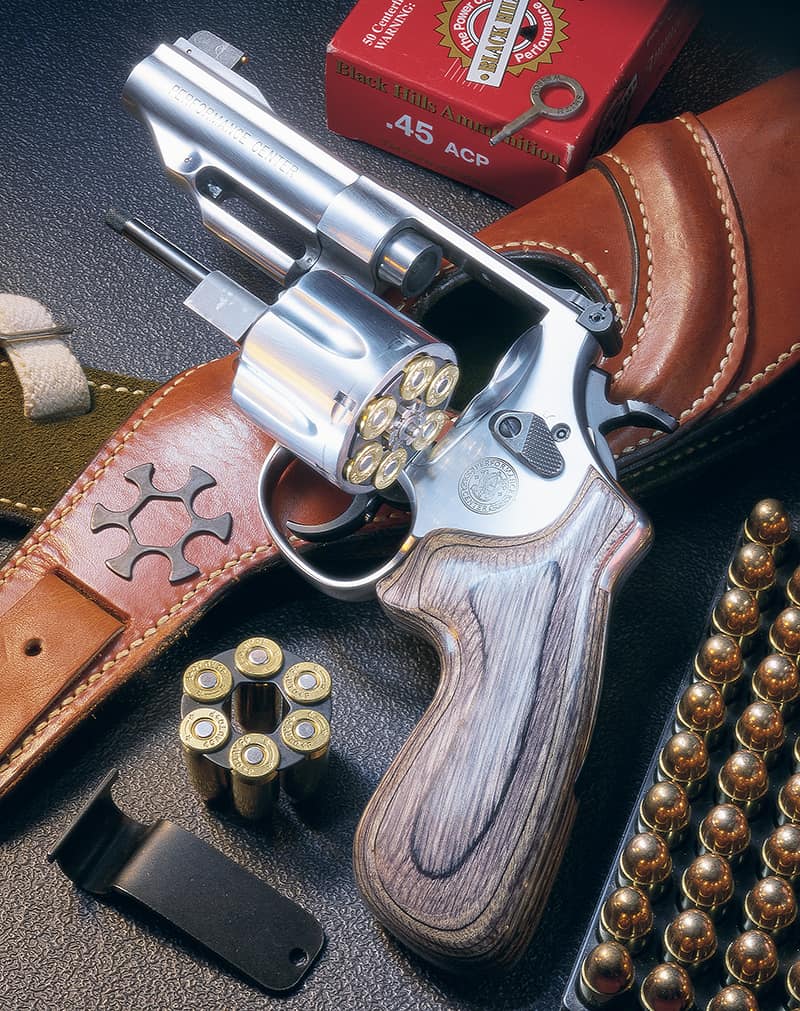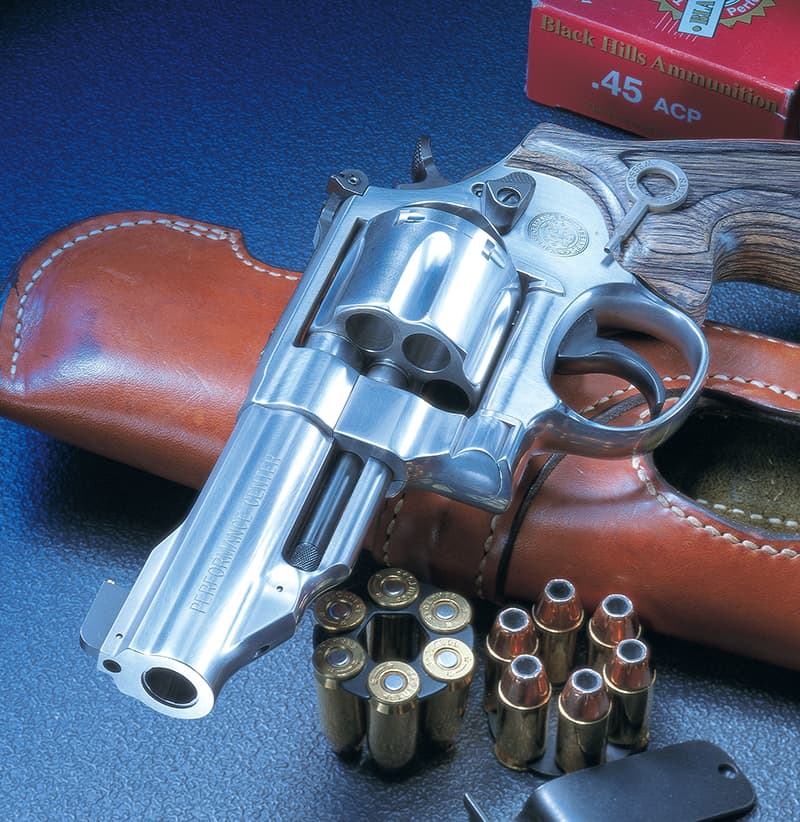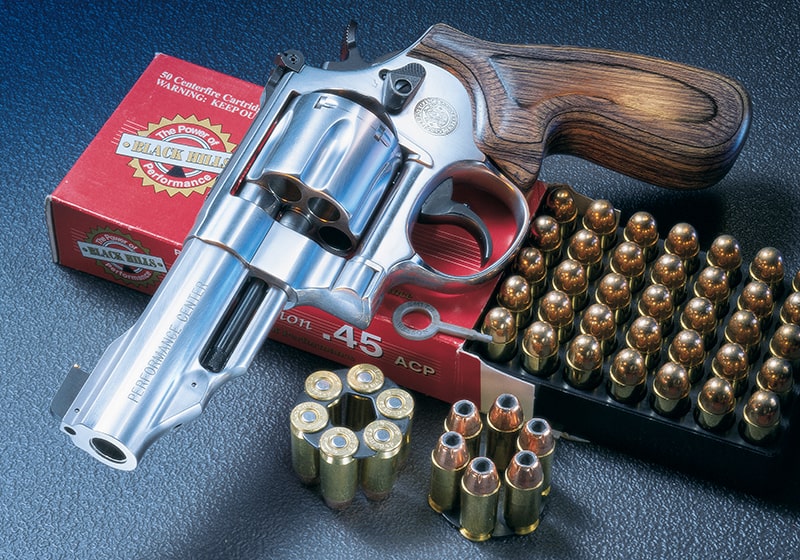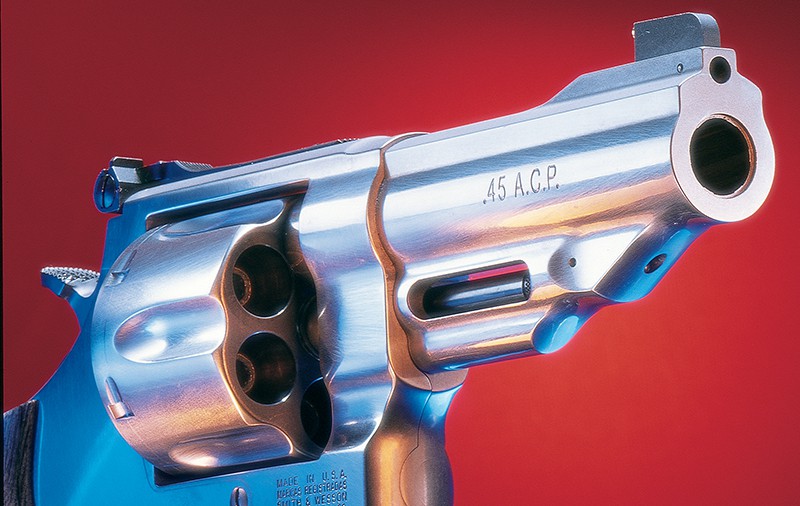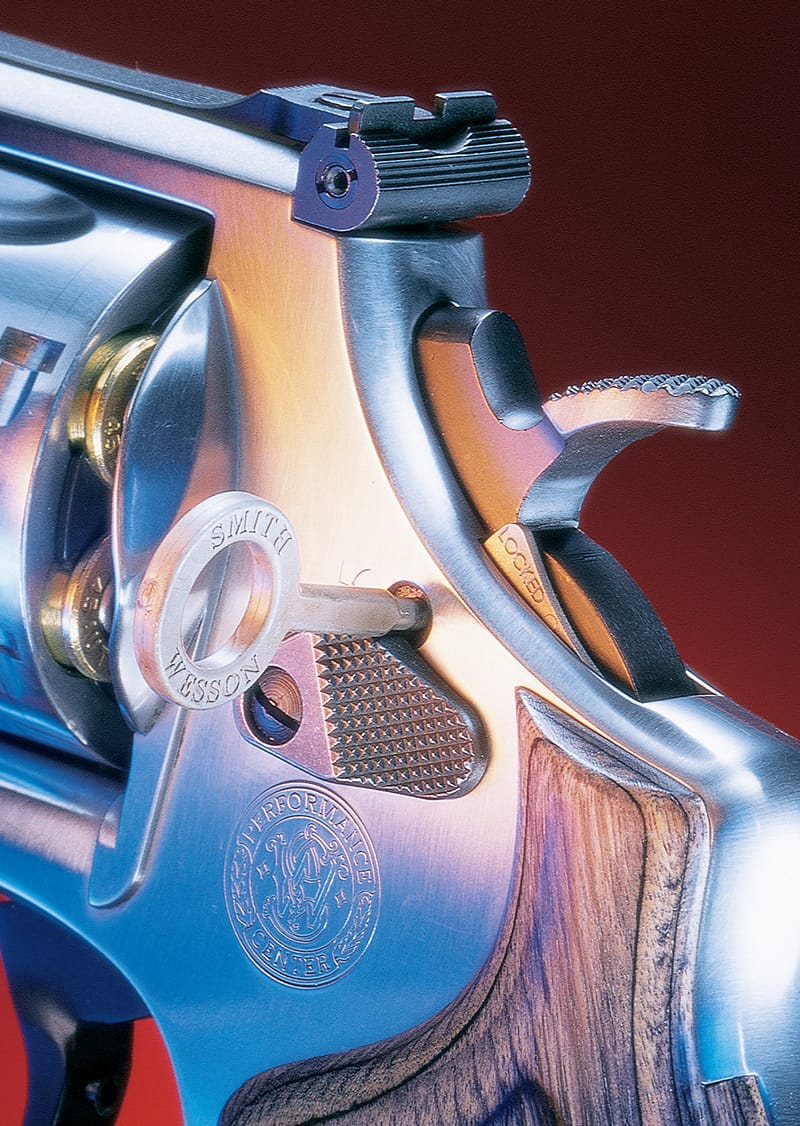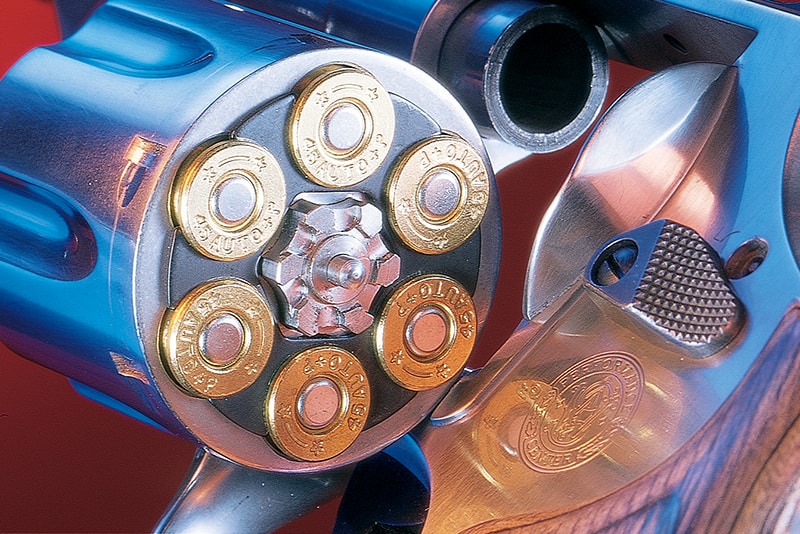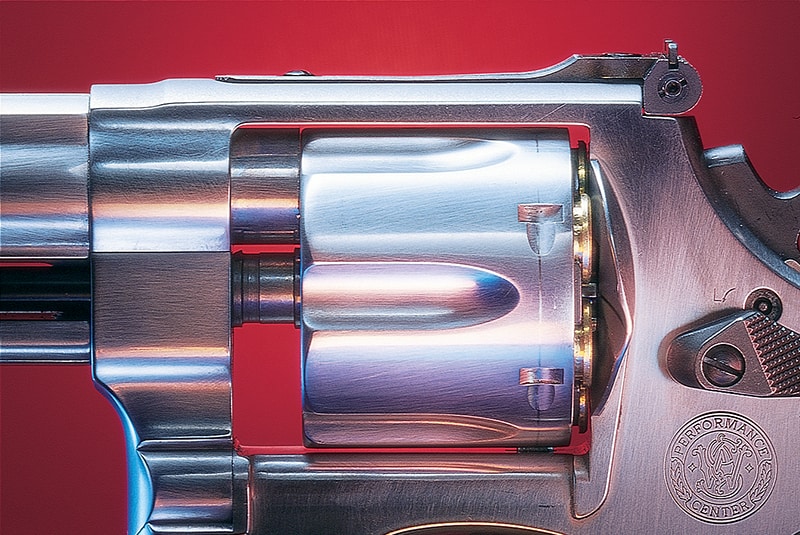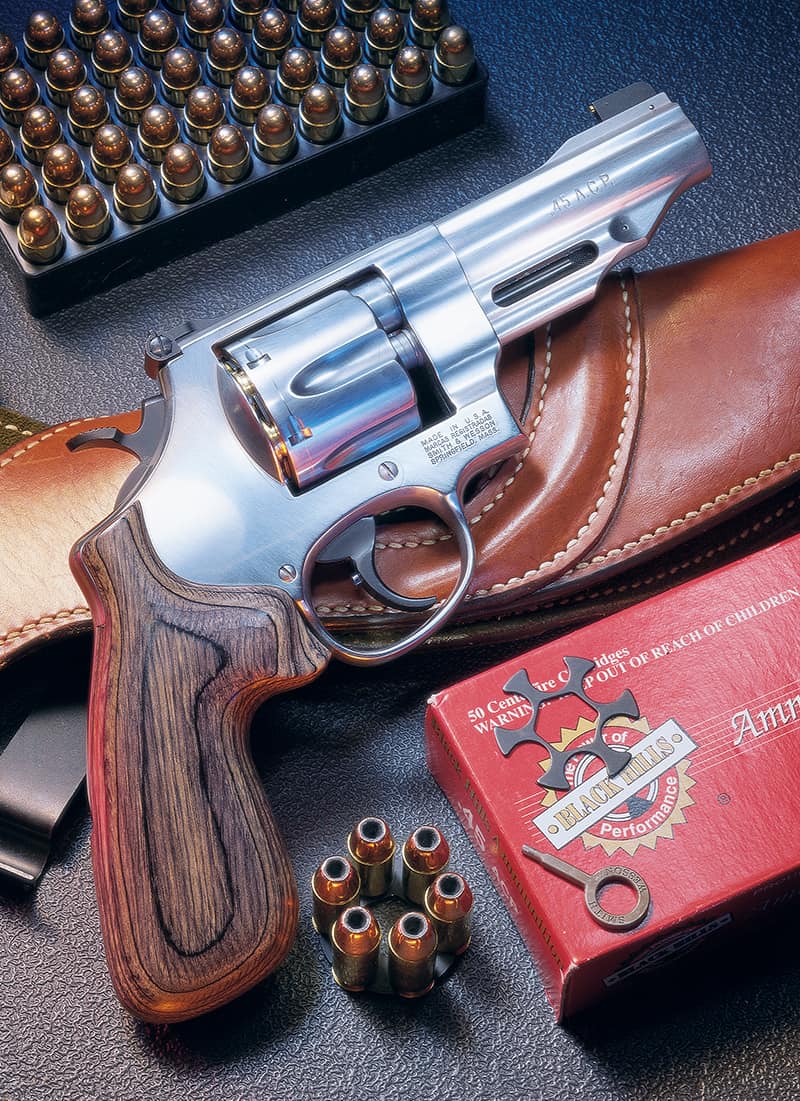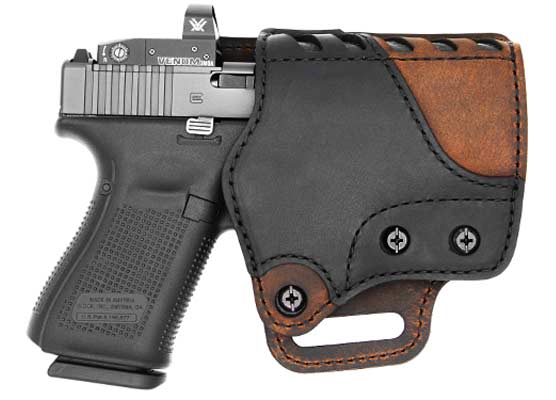The "Miculek Special"
S&W Performance Center 625
Every gunny knows the history of the 1917 revolver. How American industry couldn’t build enough Colt 1911 .45 automatics for the handgun-intensive trench warfare the nation had just entered, and how Smith & Wesson came up with half-moon clips that would allow their large frame revolver and Colt’s to handle the rimless auto pistol cartridge.
Countless 1917 revolvers served in WWII as well. S&W subsequently produced it in small quantities as their commercial grade Army revolver, but always enjoyed more success with its target version, dubbed the 1950 Model. Auto pistol technology of the time had not yet made a .45 auto as accurate as a target revolver easily available, nor one with a very light trigger that would last a while and still be safe.
Many a civilian target shooter chose to thumb-cock the S&W 1950 Target for each shot, taking advantage of its good accuracy and easy single-action trigger. Among these was a WWII Marine sniper named Jim Clark. He convinced S&W to incorporate a few refinements, including a heavier, untapered barrel, and the 1955 Target was born. A couple of years later, when Smith & Wesson adopted numbers for all models, this fine sixgun became the Model 25.
Along the way, Jim Clark, had become the first private citizen to win the overall National Championship of conventional handgun shooting at Camp Perry. If memory serves, he shot the .45 stage at that memorable event with a Smith & Wesson Target revolver.
Role Of The ACP Wheelgun
Time went on. The auto came to virtually total dominance in bullseye shooting, with Jim Clark himself one of the leaders in improving the centerfire 1911 breed. Sales of the “.45 Auto revolver” languished, and S&W discontinued the Model 25 at just about the time bowling pin shooting with revolver side-matches had created a new market for the gun. Helping this along was the advent of the full moon clip, which made this the fastest of all revolvers to reload.
Along about 1988, S&W caught on to this, and brought out the first Model 625. Not until now had the .45 ACP wheelgun been rendered in stainless. It caught on, and one or another Model 625 has been available since, either in the standard-line catalog or as a special short-run item for a given distributor.
There have been stubby ones and longer ones, compensated models, and even the svelte Mountain Gun has been chambered in .45 ACP. Now comes the latest, designed by one of the people who brought the .45 ACP revolver back to popularity.
Jerry Miculek
Jerry Miculek is one of the nicest people in the gun industry. So nice that he doesn’t bother to correct people who mispronounce his name, because he doesn’t want to hurt their feelings. For years, I introduced him to people with the pronunciation almost everyone in the business uses: “MIK-a-lik.” I found out by accident that the pronunciation is supposed to be “MISH-you-lak.”
Jerry is the “ragin’ Cajun” who came up out of the bayous of Louisiana to the bowling pin tables at Rich Davis’ Second Chance Shoot and taught all the auto shooters a thing or two about “obsolete” revolvers. Jerry’s trademark sixgun was an 8 3⁄8 inch barreled Smith & Wesson.
He started with the K-38 in that length, but quickly discovered that his pin-loads — 230 grain .38 wadcutters at velocities that probably made Smith & Wesson engineers wake up screaming in the middle of the night — just shook the .38-frame revolvers loose too soon. He went to the 8 3⁄8 inch heavy-framed Model 27 .357 Magnum, and with that gun he set every record there was at Second Chance.
One memorable year, he went home with something like 15 guns won in 15 separate events at that fabulous carnival midway of fun shooting games. At the last year of Second Chance, 1998, he showed up with a brace of the newest S&W Performance Center guns, Model 627s with eight-round .357 cylinders. These long-tom .357s were what he used against the autos.
The Need For Speed
In the revolver-only event, he set the records too, but here he used a Model 625 with moon clips and ball ammo for the mandatory reload. He could react to the start signal, bring up the 625, blast six bowling pins off the table, reload, and take two more in under six seconds.
If it was his skills in blasting bowling pins that made him known to competitive handgunners, it was his performance on TV that made his name a household word among gun enthusiasts who don’t shoot the matches. He set two records. Eight shots (and eight hits) in one second flat with .38 Special rounds out of a 627… and his sub-three-second 12 shot revolver string.
Countless millions have sat glued to their televisions as Jerry fired six rounds, reloaded with a moon clip of roundnose .45 ACP, and fired six more — all hitting the target — in 2.99 seconds, including reaction time to the start signal.
The gun he used for the latter feat was a Smith & Wesson Model 625 in .45 ACP.
Along the way, Jerry had married Jim Clark, Sr.’s daughter, Kay. Talk about continuing heritage. As with his father-in-law before him, Jerry was consulted by Smith & Wesson as to how their .45 ACP sixguns could be made better. Thus was born the gun the people at S&W’s Performance Center call the Miculek revolver.
Miculek 625
Marked on the frame as variant 625-8, this gun is available with the nicely-balanced 5 inch barrel and the 4 inch length that will soon become the maximum allowed at IDPA (International Defensive Pistol Association) events in the Stock Service Revolver class.
The sights are big and easy to see, just like on Jerry’s guns. Mine came with a square cut Patridge style front and an adjustable rear with a good-size notch, both in the plain, flat black that most serious shooters tend to prefer.
The barrel is lighter and more streamlined than the full-length underlug style seen on most factory production 625s. The ejector shroud tapers up gracefully toward the muzzle. Rather than being closed on the right side, as has been customary with S&W since the 1930s, the shroud is open on both sides.
This is a good thing. If you’ve ever had your S&W ejector rod work itself loose, you know that it moves forward against the front locking lug and locks up solid. It needs some fancy dexterity with needle-nose pliers to get in there and, with aching slowness, turn the rod back until the cylinder can be opened. With the ejector rod housing open on both sides, retightening of a loose ejector rod promises to be a much quicker fix if it should ever become necessary.
Sweet, Smooth Trigger
The trigger is smooth of surface, and polished on the edges. I know Miculek likes a serrated trigger and likes to make contact with the pad of his index finger. I also know that he knows that most shooters do better with the smooth surface and prefer to make contact with the distal joint of the trigger finger, and this set-up is ideal for that.
Being built as a sporting gun as opposed to a street defense weapon (though it can certainly serve the latter function as well as its ancestors did on the battlefields) it has not been rendered double action only.
The single action trigger pull is sweet and crisp. The hammer spur has the triangle shape that has come from the Performance Center of late; easy to thumb back, but not big enough to get in the way of a fat hand and block the hammer’s movement.
The double action is as nice as I’ve ever seen on a Smith & Wesson .45 ACP revolver that hadn’t been tuned by a master gunsmith. The stroke is smooth and even, S&W’s famous one-stage double action pull, done as nice as the caliber will allow.
I say that because a .45 ACP revolver is always going to need a heavier pull than one which is chambered for a conventional revolver cartridge. Those springy half- and fullmoon clips can let the cartridge move ever so slightly forward under the blow of a firing pin, and that little headspace hassle means that the hammer needs more than the usual amount of “oomph” to guarantee ignition.
When you look at the variety of handloads likely to be fired in a revolver like this, not to mention military surplus ammo from strange lands, it’s pretty tough to get a .45 ACP revolver’s DA pull down much below eight or nine pounds and keep the gun reliable. I would guess this one’s DA pull weight at about nine.
The Safe-T-Hammer integral lock is present, its keyway sitting atop the current style cylinder latch. A lot of shooters think this is anathema and wish it wasn’t there, but I don’t see any way it can lock things up by itself, and if you don’t like it you don’t need to use it. The Performance Center logo is crisply stamped below the cylinder latch.
Great Gray-Green Grips
The stocks are the first thing that catch your eye. Earthtoned in what some have called “camo lamo,” these slender Hogues are exactly the design that Jerry Miculek created for his own needs. They are delightfully slim, guaranteeing a good reach to the trigger if you have average size hands.
The fill-in portion behind the trigger guard is broad on its surface in the fashion of Bill Jordan’s classic stock design. However, where Jordan stocks filled in a considerable area behind the back-strap of the grip-frame, the starkly narrowed Miculek design is cut right to the backstrap to allow maximum trigger reach. For those who carry a gun this big concealed, the trim lines of the Miculek grips should help to hide the 625.
The second thing a seasoned sixgunner will spot is the unusually short cylinder. Made since 1917 with full-length cylinders designed for big revolver cartridges like the .44 Special, the short .45 Auto cartridge’s bullet has always had to take a long leap from the chamber to the barrel’s forcing cone.
Over the years, a handful of enterprising revolversmiths have shortened the cylinders and commensurately set back the barrels, convinced that this delivered better accuracy. This is the treatment given to the Miculek 625, and to the best of my knowledge it is the first such revolver that S&W has produced.
Finally, noting that most IDPA and bowling pin shooters rolled their own ammo, Jerry suggested that the rifling be cut extra deep, the better to suit lead bullets. This, too, has been done. Old-style broached rifling has been cut .001 inch deeper than usual, with the same right-hand twist of 1:15 that S&W uses on all their .45 ACP handguns.
On The Range
For reasons no one has pinpointed to my knowledge, stainless S&W revolvers in this caliber do not seem to deliver the tight groups their carbon steel predecessors were famous for. Jim Clark Sr. won the nationals with one of the fine old blue guns.
I had a 1955 Target (five-screw, pre-Model 25) that I used in .45 bullseye matches for years because it out shot every .45 auto I owned. Andy Cannon built me a Model 25-2 with a carbon steel Douglas barrel as a PPC gun that was also a tack-driver.
Combat Accurate
I’ve not seen this accuracy with the stainless guns. The first 1988 Model 625 I tested showed mediocre accuracy with most jacketed rounds, but when I shot it with Black Hills lead bullet ammo, it gave one-hole groups at 25 yards. The last 625 I tested, with the removable V-Comp, did 1.85 to 2.85 inches with most loads at that distance.
Compared to the S&W .45 Targets of Jim Clark’s day, this newest gun’s accuracy could only be called disappointing. The one brand of frangible bullet ammo I tried was all over the target and occasionally off it.
I tried seven different types of ammo, four of which I’ve won matches with in other .45s and two of which I’ve used to win state championships. Almost all were in the three- to four-inch range for five shot groups at 25 yards. Only two did better.
Black Hills 200 grain lead semiwadcutter punched five clean holes that measured 2 3⁄8 inch apart center to center, the best three in an inch and one-sixteenth. Federal’s famously accurate full metal jacket “softball” load, the 185 grain semiwadcutter Gold Medal Match cartridge, delivered a group one-sixteenth of an inch tighter than the Black Hills, with the best three in an inch and a half.
My first thought was, “It’s me. I’m having a bad day.” I unlimbered my carry gun of the day, a Smith Model 4506 that’s usually about a two-and-a-half-inch gun at this distance. The carry load, 200 grain Tactical +P from Pro-Load with Gold Dot bullets, went into 2 1⁄8 inches, and the Federal Gold Medals went into 2 1⁄2 inches.
Now, S&W’s target autos, the Model 52 Master .38 wadcutter gun and the Performance Center’s own Model 952 and PC5906 in 9mm, will shoot right along with the same maker’s typical target revolvers. We’re talking one-inch groups at 75 feet. Fit loosely for mil-spec function, their duty autoloaders as a rule of thumb will shoot a group twice the size of their premium target sixguns. For a Smith duty auto to outshoot a Smith target revolver is almost unheard of. It should not occur in Nature.
I called the Performance Center, and a couple of guys there took a Miculek 625 and set it up in a Ransom Rest, testing with the .45 ACP ammo they had on hand, Federal Hydra-Shok and Speer Gold Dot. An hour later, I got a call back. They, too, were getting three and four inch groups at 25 yards.
It turns out that the Performance Center puts a minimum acceptable group with this gun at four inches.
“If we had a Model 945 (.45 auto) that shot like this, we’d throw the barrel away and fit another one,” said a Performance Center staffer whom I think should remain nameless. “It’s just something about the .45 ACP revolvers.”
I personally think it’s something in the standard-size stainless steel barrels that hasn’t been diagnosed yet. The massive slab-sided stainless tube in the V-Comp had done better. The old 1950 and 1955 Target barrels made of 4140 or 4130 chromemolybdenum steel had done way better.
But that was then, and this is now. The target revolver has been gone from the precision-demanding bullseye ranges for a long time.
Put Into Context
The Miculek 625 is geared for pin shooting and IDPA matches. The standard bowling pin distance with handguns is 25 feet, not yards. In a 90-shot IDPA Classifier match, you won’t fire a single shot at 25 yards, and only 18 at 20, and the high scoring center ring on the official IDPA target measures eight inches in diameter. With the exception of the frangible bullet loads, the test gun kept everything comfortably inside that margin.
In the superb new Krause publication The Gun Digest Book of the 1911, ace competitor and seasoned pistolsmith Pat Sweeney finds himself testing a .45 auto that shoots groups similar to those of this test revolver. He makes a cogent point:
“We should be careful about becoming jaded with accuracy testing. Even with the loads it liked less than these, the (1911 in question) can easily keep its hits inside the ‘A’ zone of an IPSC target at 50 yards.” An IPSC silhouette’s “A” zone measures about 11 inches high by 6 inches wide.
Feel Of The Beast
Groups notwithstanding, I would have been happy to shoot this gun in the 2002 MidWinter IDPA championships hosted by Smith & Wesson, and damn near did. The only reason I didn’t was that I had to go there direct from a 12-day tour somewhere else where I had to carry concealed, and even with the slim Miculek grips, N-frame revolvers do not conceal terribly well on my K-frame body when I have to wear a suit.
That said, I later found the gun to be concealable under a loose jacket in a Kydex inside-the-waistband holster furnished by Blade-Tech. The same company’s vertical belt scabbard would be my choice for IDPA competition, and it mates very nicely with the Wilderness Tactical nylon dress gunbelt also offered through Blade-Tech.
In fast shooting, the Miculek revolver lives up to its name. I can’t shoot as fast as Jerry unless I do it on videotape and then run it “fast-forward,” but the sweet trigger stroke from the Performance Center lets any of us live up to our best potential sixgun speeds.
The grips weren’t for me, though. After sustained shooting, particularly with +P ammo, the proximal joint of my thumb was feeling it and the fairly sharp bottom edge of the filler portion was starting to nail my middle finger. Jerry is young and strong, while I am old and obviously getting soft. The cushy composite Hogue grips tend to work best for me on S&W’s .45 revolvers.
This Performance Center special is being produced for the distributor Camfour. Interestingly, it does not have a suggested retail price. The distributor leaves that up to the dealers. A source I spoke to at Camfour guessed that most shops would be selling these guns for about a thousand dollars.
The Bottom Line
I found it utterly reliable. The moon clips can be a pain, and for plinking you can do without them, as the cartridges will headspace on the case mouths. This is something between a convenience and a life-saver if you ever really need your Model 625 on (nyuk, nyuk) some “moon”- less night.
Even with +P, the spent shells came out cleanly at the touch of a fingernail. However, I did get better accuracy with most loads when I used the moon clips. It’s that headspace thing again. It has an effect on ignition, which in turn has an effect on accuracy. You could always use .45 Auto Rim cartridges, but finding them is somewhat more difficult than finding a black and white TV set these days.
I think you’ll be seeing a lot of these slick sixguns at IDPA matches in days to come. Every .45 ACP fan needs a revolver in the caliber. If nothing else, it’s a fun garbage disposal for the handloads that come out too light to cycle in your favorite auto, or those with mouths too blunt to feed in your 1911.
The Camfour/S&W Performance Center Miculek Model 625 will do all that. And it will carry with it the karma of Jim Clark, Sr. and Jerry Miculek, two of the finest gentlemen to ever honor our lifestyle by not only participating but excelling in it.

Get More Revolver Content Every Week!
Sign up for the Wheelgun Wednesday newsletter here:
